How To Reboot A Tesla Model S & Common Issues It'll Fix
There are many reasons why you shouldn't buy a Tesla Model S, but the American EV pioneer remains a dominant force in the growing EV segment. In the latest report by S&P Global, Tesla has a five-year lead over other automakers in its in-vehicle electronic and unique zonal electrical architecture.
But despite this, no Tesla Model S is without fault. Sometimes, the center touchscreen stops responding to touch inputs or displays generic error codes. A quick Google search reveals "rebooting" or "restarting" your Tesla might be the solution, but how do you restart or reboot a Tesla Model S when, unlike a smartphone or tablet, there's no restart button in sight?
Before we get to the nitty-gritty of how to reboot a Tesla Model S, it's essential to know the difference between a soft and hard reboot and the underlying problems that each could solve.
Tesla Model S: What's the difference between a soft and hard reboot?
The Tesla Model S has two tiers of a "soft reboot" or "soft reset": touchscreen reset and power cycling (full vehicle reset). The former restarts the underlying software without cutting power to the onboard electronics, while the latter has more systems involved and turns off the power before coming back to life.
Meanwhile, a hard reboot involves discharging the electronics by disconnecting the 12V battery. You should only consider hard rebooting your Tesla Model S if:
- A soft reboot didn't solve the issue
- You live far away from a Tesla Service Center
- Have experience fiddling with the EV's high-voltage equipment
What issues will a soft reboot fix?
Computer and software glitches in a Tesla are few and far between, but they do happen. If you notice the following issues in your Tesla Model S, a soft reboot might be the answer:
- An erratic or unresponsive touchscreen
- Network connectivity problems
- Software update glitches
- When Tesla service recommends turning the car off and on
How to soft reboot a Tesla Model S
Here are the steps to soft reboot a Tesla Model S. The procedure applies to Tesla Model S and Model X equipped with MCU1 and MCU2 and will reset the touchscreen, instrument cluster, or both.
Step 1: Park the vehicle. It's possible to perform a soft reboot while driving, but we strongly recommend doing it when the car is not moving.
Step 2: Press and simultaneously hold the left and right scroll wheels on the steering wheel.
Step 3: Wait ten to 30 seconds for the screen to go dark before releasing the scroll wheels. The screens will refresh shortly.
How to do power cycling on a Tesla Model S
If a soft reboot fails to remove the glitches, performing a "power cycle" or "soft reset" procedure might help. The steps below apply whether the touchscreen is functional or not.
Step 1: Park the vehicle and keep all the doors closed.
Step 2: Press and keep your foot on the brake pedal.
Step 3: Press and hold the two scroll wheels on the steering wheel.
Step 4: Keep pressing your foot on the brake and your fingers on the scroll buttons until the screen comes to life.
If all the above fails to rid your Tesla Model S of particular software glitches and touchscreen problems, do not hesitate to schedule a visit to the nearest Tesla service center.


